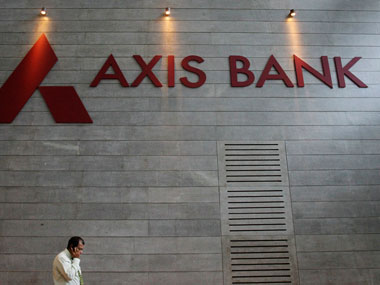The last-minute success of the government’s efforts to raise resources in 2013-14 by selling shares in Axis Bank and an exchange-traded fund (ETF) is the result of two factors: the NaMo bounce in the markets, which improved investor interest in buying some of the shares, and the usual wink-and-nudge transfer of stake holdings from one pocket of the government to another, using the Life Insurance Corporation (LIC) and vehicle.
The upshot of this success is largely negative: there is a concentration of financial holdings in the LIC, making the financial system itself more vulnerable.
[caption id=“attachment_77710” align=“alignleft” width=“380”]  The Axis Bank sale is not a triumph of disinvestment strategy. Reuters[/caption]
The government has raised Rs 5,500 crore by selling 9 percent in Axis Bank, and another Rs 3,000 crore by hawking an ETF worth Rs 3,000 crore, which will buy some public sector shares from government. The bulk of the remaining money came from transferring money from one pocket to another: LIC bought many public sector and bank shares this year, including 5 percent of Bhel; Oil India and ONGC were asked to swallow 5 percent each in Indian Oil; and even in the Axis Bank sale, 20 percent of the shares on offer went to the LIC since foreign institutional investors (FIIs) did not have much headroom to buy in this company.
Overall, the government raised Rs 21,700 crore - much higher than the downscaled disinvestment target of Rs 16,000 crore. But if we exclude the Axis Bank sale, which is really not disinvestment of public sector shares, the actual money garnered is just about what the target indicated.
A good reason to exclude the Axis Bank sale from the disinvestment total is that this stake was inherited by the government while bailing out UTI’s Unit 64 scheme over 10 years ago. With many of Unit 64’s underlying stocks turning into dud investments, the government issued tax-free bonds to investors through the Special Undertaking of the Unit Trust of India (SUUTI). In the rubble of worthless shares inherited by SUUTI, the government discovered three gems - Axis Bank, Larsen & Toubro and ITC. These shares were not public sector shares, but investor-owned private sector shares that the government acquired while bailing out Unit 64.
Exclude Axis Bank, and the transfer of Indian Oil and Bhel shares to government-owned undertakings, and the net disinvestment will really look pathetic - less than Rs 10,000 crore. And even here, one may find more LIC bailouts. That there were few investors willing to pay good money for fundamentally sound blue chip public sector companies tells us how low the UPA’s credibility has fallen.
However, while all this may have enabled P Chidambaram to reduce his budget deficit, danger lurks elsewhere - in the Life Insurance Corporation.
When one 100-percent government-owned company like the LIC keeps on buying shares, two things happen.
One, LIC ends up becoming India’s largest holder of public sector shares - and to that extent disinvestment has not happened at all. Policyholders’ funds have been swiped by the government, and if the LIC gets into any solvency problem because the stock market underperforms for a long time, the government will end up having to bail out LIC itself.
Two, LIC is getting into a moral hazard where it is now also the biggest owner of bank shares. In Axis Bank, of which it is one of the promoters, it owns 11.14 percent - which is now similar to SUUTI’s remaining holdings of 11.72 percent. At the next sale tranche, LIC could well become Axis Bank’s biggest shareholder.
For the last two years, LIC has also been recapitalising banks by buying up their new shares because the government’s pockets are empty. A Financial Express report notes that LIC’s holdings are “already in excess of 10 percent in… Corporation Bank, Vijaya Bank, Bank of Baroda, Bank of India, Syndicate Bank, Allahabad Bank and UCO Bank.” It owns shares in many other banks, including the State Bank of India.
It is interesting to note that an LIC subsidiary, LIC Housing Finance, is in the queue for a new banking licence. One wonders why it needs its own bank when it already owns a huge chunk of the banking system. Any one of these banks could have been made its subsidiary or merged with LIC Housing Finance by shifting investment holdings to core holdings.
But the larger point is this: the Indian financial system is now substantially vulnerable as many of its eggs are now in the LIC basket - a basket owned 100 percent by the Indian taxpayer, but which is used sometimes like a safety deposit vault to park blue chip shares and at other times like a waste basket for unsaleable public sector shares.
The Indian taxpayer should be worried, really worried.


)
)
)
)
)
)
)
)
)



